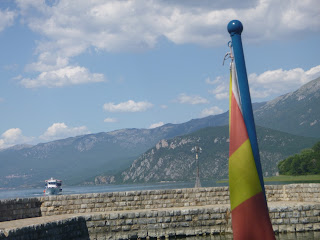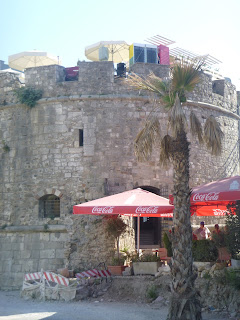At the end of June we set out on a really odd, most appealing trip, leaving Penang for Georgia, Macedonia, Sardinia and Sicily, passing through a few other assorted places en route.
͊
First was Georgia, starting with a day and a half in Tbilisi, letting the relief of having successfully made our Malaysian exit sink in, and revisiting some places familiar to us from our time living in Azerbaijan, when we happily escaped it's grey and forbidding spirit to relax in Gorgeous-stan.The warmth of Georgian summer felt positively voluptuous, deeper somehow in it's temperateness compared to the constant, lush heat of tropical Penang. Present in the capital, Tbilisi, yes, but even more so outside it in the small towns we visited: Gori and Kvareli.
Salads of ripe red tomato, cukes and super fresh purple basil or sometimes dill--not minced beyond recognition as we might do in N. America but given in bold pieces.
We took the cable car up the hill and T enjoyed his first kinkhali overlooking Tbilisi.
 |
| view of Tbilisi from top of Mtatsminda Hill |
 |
| kinkhali |
We had planned to fly in a small plane to the Svaneti area of the Caucasus Mountains, but after waiting some hours in a small airport outside Tbilisi, the flight was finally cancelled due to "clouds." Most of the other (8 - 10) travelers then arranged to go by car (7+ hours) but we scrambled to make other plans, namely getting to Gori two days earlier than expected, and adding a visit to the Khaketi area after that. The owner of the Gori guesthouse kindly drove 1 1/2 hours to pick us up herself.
Gori was a much nicer town than we had imagined. A few derelict Soviet era factories, yes, but vibrant shops and lovely parks. Apparently many tourists visit because it is the birth place of Stalin, but our interest lay in Uplistsikhe, an ancient city fortress about 10 miles outside Gori. It dates from the early Iron Ago to the late Middle Ages. Impressive!
 |
| carved "beams" made to look like wood! |
 |
| tunnel to exit |
 |
| carpet featuring his likeness |
With daughter's help, we hired a driver to get us to Kvareli, in the famous wine-growing region of Khaketi, about 1 1/2 hours east of Tbilisi. Gori is 1 1/2 hours west of Tbilisi. If there were any useful road signs they were all in Georgian, so we were very glad to have a driver. Not that it was easy for him either--we seemed to have overshot the small town of Kvareli we were aiming for, eventually arriving an hour or two later than planned.
On the way, two YIKES: 1) stopping to fill up on natural gas at a gas station, the driver lights a cigarette; and 2) road signs near Tbilisi announcing mortal enemies Baku and Yerevan together on one sign--horrors!
Once found, Kvareli was a sweet little town at the foot of the Caucasus, and home to a famous winery, which operated a charming hotel. Our very comfortable, modern room faced a park-like square sitting between the hotel and the police station, that was full of life at all times of day with people passing through, but especially in the evening, up to 11 pm even, people sitting, chatting, even famiies with kids that late. It didn't get dark until around 10 pm but the community carried on a good deal later.
Next to the hotel was an old fortress. Best use for an old fortress EVER: it is a soccer field.
We walked out of town to a lake
Street scene
Random note: Countries where women walk alone, unafraid--Georgia is one.
On to Macedonia. We had met a teacher from Macedonia in Penang, and had never been to this part of Europe, so...
The Republic of Macedonia (generally confused with the province of Macedonia in Greece, which is nearby) is south of Kosovo, east of Albania, west of Bulgaria. It is required to formally call itself "The Former Yugoslav Republic of Macedonia (FYROM)" because Greece will not have them using the name. We flew into it's capital, Skopje. An appealing town but apparently not always so.
We heard that people were happier as part of Yugoslavia under Tito, who managed to create harmony among disparate ethnic groups (he was half Serb and half Croatian). Tito's rule offered stable socialism where citizens were free to travel (and to speak), unlike nearby Albania or Romania.
Macedonia recently emerged from 11 years of corrupt government, through an election monitored by the EU, which saw multiple opposition groups united against the regime. One massive project of the previous administration was actually far-sighted but at the time incurred the wrath of much of the populace. Referred to now simply as "2014", as in "the terrible plan that was undertaken in 2014", it was intended to draw tourists, which it has done. A large area of the city was razed, and added were fountains, grand buildings, bridges lined with statues, and--where we stayed--a four star hotel in a wooden "ship" built in the shallow river. At the time, people saw that there were schools and hospitals to be built, but millions were spent instead to turn downtown Skopje into a picture post card.
We found it a welcoming mix of churches (Mother Teresa was born here, a fact perhaps disputed by the Albanians?) and mosques, friendly people, great beer, and wine finer than we found in major wine-exporter Georgia. Grand museums are too new to have extensive collections and the Museum of the Oppressed, AKA the Fighters, required a one hour guided tour perhaps so we would become well educated in a favored version of history. We skipped it.
 |
| Turkish part of town! |
 |
| Statue of guy whose name begins with "A" |
 |
| our hotel |
 |
| our hotel room |
 |
| at a cafe on the main square |
 |
| from our balcony :-) |
 |
| cobblestone streets of the old town |
Great food!
In the old town we came across an excavation of what looked like a Roman villa, with mosaics from the 4th or 5th C, under a protective roof. There was no sign or door, and it was open to whatever public happened to wander by.
A rowboat took us to an "Underwater Garden", a UNESCO
protected (Yay, UNESCO!) area of crystal clear water at the foot of Mt.
Galicica, with springs bubbling up underneath.
Aside from the Underwater Garden, St. Naum features a fortress,
church, restaurant and plenty of day-trippers.
Back in Ohrid, we had the great fortune to be in town for The
Annual Balkan Folk Festival, held in an open air theater overlooking the lake
and the mountains beyond--fabulous.
We left Lake Ohrid and Macedonia for Durres, the port in Albania
from which we were scheduled to take an overnight ferry to Bari, Italy. We
avoided no doubt great but time-consuming adventure on a series of buses in two countries by hiring a car and
driver. it was comfortable and way faster than expected--around three
hours from Ohrid to Durres, bypassing the Albanian capital, Tirana.
Albania seemed wilder, poorer, and simpler than Macedonia. We
passed along the far side of Lake Ohrid and through dramatic hills at the
Macedonian border. We stopped briefly in Elbasan, its fort and clock
tower with Arabic numerals pictures here:
We arrived in Durres on the Adriatic coast, earlier than expected,
giving us a full day there to explore. Durres is a pleasant port city,
with missed opportunities to inspire and direct tourists--we suspect like much
of Albania.
An unexpected offering in our hotel room:
Here is the port, and the beach strip
The beach strip has several hotels and restaurants.
Roman ruins dot the area
Ah, Italy. Stylish women, even those with less than "ideal"
figures. comfortable in tight dresses, lots of jewelry. The side streets
of the old town give a bit of the feel of Napoli. We visit the Norman fortress,
which later became a castle. We take a relaxing evening walk. Lots
of families out, siting after a long hot day either outside their homes or at
sidewalk cafes.
























































